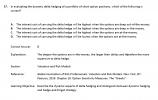I have a question about this GARP question:
Question 37. In evaluating the dynamic delta hedging of a portfolio of short option positions, which of the following is correct?
A. The interest cost of carrying the delta hedge will be highest when the options are deep out-of-the-money.
B. The interest cost of carrying the delta hedge will be highest when the options are deep in-the-money.
C. The interest cost of carrying the delta hedge will be highest when the options are at-the-money.
D. The interest cost of carrying the delta hedge will be lowest when the options are at-the-money.
Correct Answer: B. The deeper the options are in-the-money, the larger their deltas and therefore the more expensive to delta hedge.
I understand that the delta of a, say call, option is logistic type, which has largest value when deep-in-the-money (AND changes FASTEST at-the-money, i.e. largest gamma).
My question is why the dynamic hedge has the largest cost when delta is large? I sort of agree that with larger delta, we need to buy more underlying. BUT, this is the "initial static" part of the dynamic hedging.
I think the reason for the cost of dynamic hedge is large is because the delta constantly changes, so that a trader has to rebalance all the time, which corresponds to the largest gamma situation, i.e. at-the-money.
Did I miss Anything? or it is somehow related to the "interest cost of carry" (not the overall cost) so that we need to borrow money to buy (a lot of) underlying (so that the larger delta, the larger interest cost of carry)?
Thanks!
Question 37. In evaluating the dynamic delta hedging of a portfolio of short option positions, which of the following is correct?
A. The interest cost of carrying the delta hedge will be highest when the options are deep out-of-the-money.
B. The interest cost of carrying the delta hedge will be highest when the options are deep in-the-money.
C. The interest cost of carrying the delta hedge will be highest when the options are at-the-money.
D. The interest cost of carrying the delta hedge will be lowest when the options are at-the-money.
Correct Answer: B. The deeper the options are in-the-money, the larger their deltas and therefore the more expensive to delta hedge.
I understand that the delta of a, say call, option is logistic type, which has largest value when deep-in-the-money (AND changes FASTEST at-the-money, i.e. largest gamma).
My question is why the dynamic hedge has the largest cost when delta is large? I sort of agree that with larger delta, we need to buy more underlying. BUT, this is the "initial static" part of the dynamic hedging.
I think the reason for the cost of dynamic hedge is large is because the delta constantly changes, so that a trader has to rebalance all the time, which corresponds to the largest gamma situation, i.e. at-the-money.
Did I miss Anything? or it is somehow related to the "interest cost of carry" (not the overall cost) so that we need to borrow money to buy (a lot of) underlying (so that the larger delta, the larger interest cost of carry)?
Thanks!
Attachments
Last edited by a moderator:

